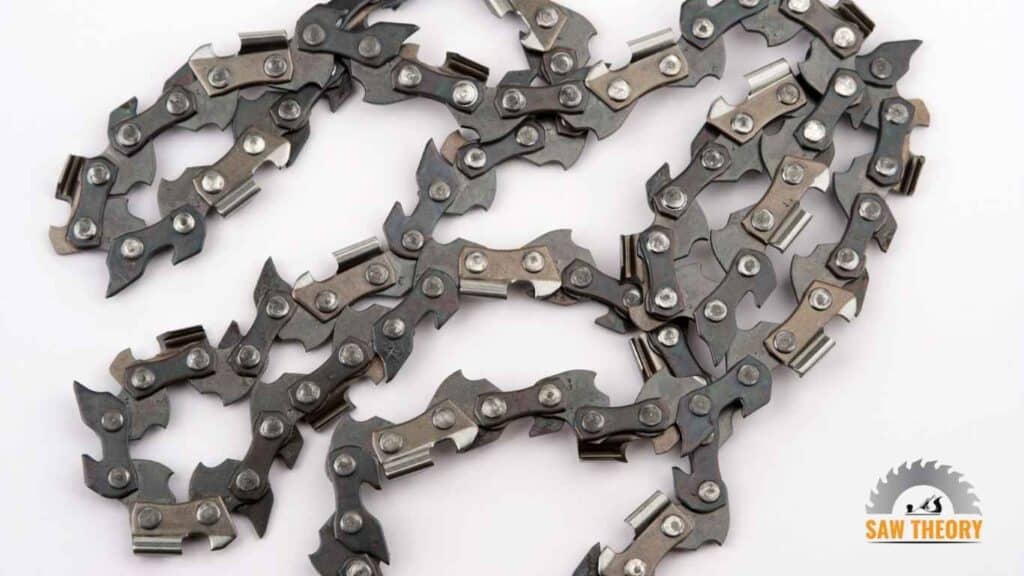The chain is the only thing that makes a chainsaw work. If you’re trimming branches, cutting firewood, or felling small trees, this sharp, fast-moving component does all the work. It is essential that you choose the right chain for your saw to ensure safety, efficiency, and longevity. Despite the fact that there are many chainsaw bar sizes, the 16-inch model is one of the most popular due to its versatility, balancing power, and maneuverability.
In this guide, we will focus specifically on 16-inch chainsaw chains. We will cover everything from key specifications to different types of chains to proper installation and maintenance. As a result, you will know how to select, use, and care for your 16 chain for a chainsaw confidently by the end of this guide.
What is a 16 Inch Chainsaw Chain?
Chainsaws with a 16-inch bar have a guide bar that can effectively cut 16 inches, not the chain itself. A chainsaw chain measuring 16 inches is made to fit a chainsaw bar measuring 16 inches. Its size is a sweet spot for many users, making it a popular choice for both homeowners and professionals.
You can use a 16 chain saw for a variety of tasks, including:
- Limbing and pruning trees
- Cutting small to medium-sized logs for firewood
- Storm cleanup and branch removal
- General property maintenance
Many popular chainsaw models are compatible with the 16 inch chain saw due to its versatility.
Key Specifications of a 16 Inch Chainsaw Chain
A 16-inch chainsaw blade must meet three critical specifications: pitch, gauge, and drive links. If you want to buy a chain that fits your saw perfectly, you should understand these terms.
Pitch: It indicates the average distance between two rivets on the chain. The most common pitch is 3/8″ and .325″. It is important that the chain pitch matches the drive sprocket and bar tip pitch of your saw.
Gauge: This refers to the thickness of the drive links, which fit in the groove of the guide bar. The most common gauges are .043, .050, and .063. An incorrect gauge results in chains that are too loose and risk derailing, or too tight and cause binding and wear.
Drive Links: Drive links are the total number of links per loop of the chain. A chain’s overall length is determined by this number. Chainsaw chains of 16 inches don’t have a universal drive link count; they vary by model and manufacturer. Your old chain must be counted, or your saw’s manual must be checked for the correct number of links.
These three numbers are usually stamped on the guide bar itself or listed in your chainsaw’s manual. In order to fit Craftsman’s chainsaw chains, for example, the chain would need a 3/8″ pitch and a .050″ gauge, with 56 drive links.
Types of 16 Inch Chainsaw Chains
Chains are not all created equal. Cutting speed, smoothness, and sharpness are determined by the type of cutter on the chain.
Full Chisel vs. Semi-Chisel vs. Chipper
Full Chisel: Chains with sharp, square-cornered teeth cut through wood fibers quickly and aggressively. While they are the fastest-cutting option, they also dull more quickly, especially in dirty or hardwood conditions. Professionals who work with clean softwood are best suited to use it.
Semi-Chisel: Semi-chisel chains have rounded corners on the cutting teeth, making them more durable than full chisel chains. It cuts slightly slower, but stays sharper longer and is more forgiving when it comes to mixed wood or dirty wood. Most users will find them to be a great all-purpose choice because of this.
Chipper: A variation of the semi-chisel, featuring an even more rounded cutter. Although it is the slowest of the three, it is highly durable and excellent for cutting in dirty conditions.
Standard (Low-Kickback) Chains
Low-kickback chains are most commonly sold to homeowners. Rotational kickback is a dangerous situation in which a saw’s tip catches on wood and rotates back toward the operator due to extra guard links or modified cutter shapes. A low-kickback chain is highly recommended for non-professional users due to safety concerns.
How to Choose the Right 16 Inch Chainsaw Chain
Choosing the right chainsaw chain for your 16-inch chainsaw involves matching the chainsaw’s specifications with your cutting requirements.
The first step is to determine the chainsaw model’s pitch, gauge, and number of drive links. The information provided here is non-negotiable. Chains with the wrong specifications can cause serious damage to your saw and pose a serious safety risk.
Next, think about how you typically use your computer. You should use a low-kickback semi-chisel chain if you occasionally cut firewood and trim branches. Professionals who need to make fast, clean cuts in softwood may prefer a full-chisel chain, provided they are trained to handle the increased kickback risk.

Installation and Maintenance
A 16-inch chain saw blade will last longer and perform more safely if it is installed and maintained properly.
Installation and Replacement
01. Safety First: Make sure the spark plug is disconnected before starting the engine. Protect your hands from the sharp cutters by wearing gloves.
02. Loosen the Bar: Remove the nuts that hold the side cover and guide bar in place. If the chain is too tight, loosen the tensioning screw.
03. Remove the Old Chain: Lift the old chain off the drive sprocket and bar by removing the side cover and sliding the guide bar forward.
04. Install the New Chain: Make sure the cutters on the top of the bar are facing forward when you loop the new 16 chainsaw chain around the sprocket. Ensure that the drive links are seated in the grooves of the bar.
05. Reassemble and Tension: Replace the side cover and tighten the nuts by hand. Pull the chain by hand while holding the nose of the bar up and turning the tensioning screw. Chains that have been properly tensioned should not sag, but you should be able to pull them slightly away from the bar. Lastly, tighten the bar nuts.
Maintenance Tips
Sharpening: Sharp chains cut faster, produce larger wood chips (not sawdust), and are safer to use. Using a round file and guide, or an electric sharpener, you can sharpen your chain. Make sure the file size matches the chain pitch.
Cleaning: Keep the chain, guide bar groove, and oil holes clean regularly to ensure proper lubrication.
Lubrication: Ensure that the oil reservoirs for the bars and chains are always full. Chains that are well-oiled run cooler and last longer.
Replacement Signs: If your chain has damaged or broken cutters, substantial wear on the drive links, or cannot be tensioned correctly, replace it.
Frequently Asked Questions
Can a chainsaw be fitted with a longer bar?
Technically, it is possible, but generally not recommended. There is a specific range of bar sizes that the engine of a saw can power. An overly long bar on a saw reduces cutting performance, overworks the engine, and creates an unsafe imbalance. Chainsaw bars should always be sized according to the manufacturer’s recommendations.
Does any 16-inch chain fit any 16-inch chainsaw?
Unfortunately, no. To match your saw’s requirements, you must match the pitch, gauge, and number of drive links. It may not be possible for a chain from one brand to fit a saw from another if these key specifications are different.
How long does a 16-inch chain last?
Depending on usage, maintenance, and the type of wood being cut, this can vary greatly. A well-maintained chain used on clean wood can last several years with occasional use. Dirty chains may not last more than a season if they are used frequently. A sharp blade will last a long time if it is sharpened regularly.
Conclusion
The 16-inch chainsaw chain is an essential part of one of the most useful tools in your shed.
It is essential that you understand the specifications of your equipment, choose the right type for your needs, and perform regular maintenance in order to maintain its effectiveness and safety.
Make sure your new 16-inch saw chain is compatible before you buy it, and don’t compromise on safety.
When properly cared for, your 16 chain saw will be ready to tackle any job you can throw its way.
Table of Contents

